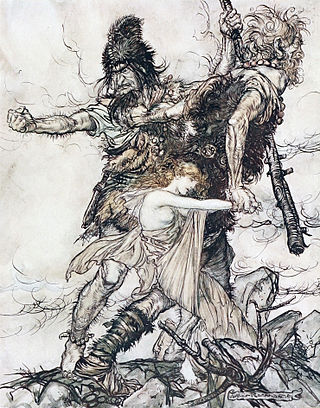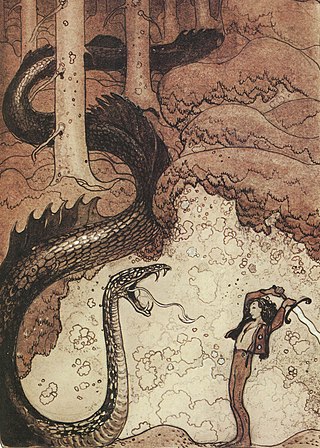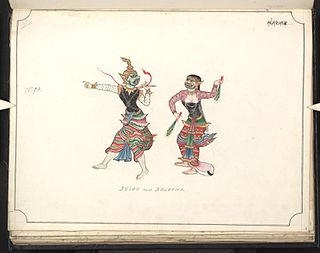
In folklore, giants are beings of humanoid appearance, but are at times prodigious in size and strength or bear an otherwise notable appearance. The word giant is first attested in 1297 from Robert of Gloucester's chronicle. It is derived from the Gigantes of Greek mythology.

The Abenaki are Indigenous people of the Northeastern Woodlands of Canada and the United States. They are an Algonquian-speaking people and part of the Wabanaki Confederacy. The Eastern Abenaki language was predominantly spoken in Maine, while the Western Abenaki language was spoken in Quebec, Vermont, and New Hampshire.

Cherokee spiritual beliefs are held in common among the Cherokee people – Native American peoples who are Indigenous to the Southeastern Woodlands, and today live primarily in communities in North Carolina, and Oklahoma. Some of the beliefs, and the stories and songs in which they have been preserved, exist in slightly different forms in the different communities in which they have been preserved. But for the most part, they still form a unified system of theology.
The Abenaki people are an indigenous peoples of the Americas located in the Northeastern Woodlands region. Their religious beliefs are part of the Midewiwin tradition, with ceremonies led by medicine keepers, called Medeoulin or Mdawinno.

The lindworm, also spelled lindwyrm or lindwurm, is a mythical creature in Northern and Central European folklore that traditionally has the shape of a giant serpent monster living deep in the forest. It can be seen as a sort of dragon.
Wendigo is a mythological creature or evil spirit originating from Algonquian folklore. The concept of the wendigo has been widely used in literature and other works of art, such as social commentary and horror fiction.

Swiss folklore describes a collection of local stories, celebrations, and customs of the alpine and sub-alpine peoples that occupy Switzerland. The country of Switzerland is made up of several distinct cultures including German, French, Italian, as well as the Romansh speaking population of Graubünden. Each group has its own unique folkloric tradition.

Glooscap is a legendary figure of the Wabanaki peoples, New Hampshire, Maine and Atlantic Canada. The stories were first recorded by Silas Tertius Rand and then by Charles Godfrey Leland in the 19th century.

Abenaki, also known as Wôbanakiak, is an endangered Eastern Algonquian language of Quebec and the northern states of New England. The language has Eastern and Western forms which differ in vocabulary and phonology and are sometimes considered distinct languages.

A wide variety of mythical creatures are found in Burmese mythology. Many Burmese creatures are part human or creatures capable of assuming human form. Most mythical creatures are endowed with humanistic mentalities, ability to converse with humans and also supernatural powers. During the 20th century, the role and diversity of Burmese mythical creatures were diversified by Shwe Thway comics which depicted the life of the Buddha, the Jataka tales and Burmese history.
The Nulhegan Band of the Coosuk Abenaki Nation is a state-recognized tribe and nonprofit organization, called AHA "Abenaki Helping Abenaki", whose headquarters and land are based in Vermont. They are often referred to as the Nulhegan Abenaki Tribe or simply, Nulhegan.

The BFG is a 2016 American fantasy adventure film directed and co-produced by Steven Spielberg, written by Melissa Mathison and based on Roald Dahl's 1982 novel of the same name. The film stars Mark Rylance, Ruby Barnhill in her film debut, Penelope Wilton, Jemaine Clement, Rebecca Hall, Rafe Spall and Bill Hader. In the film, a ten-year-old orphaned girl named Sophie befriends a benevolent giant dubbed the "Big Friendly Giant", who takes her to Giant Country, where they attempt to stop the man-eating giants that are invading the human world.








